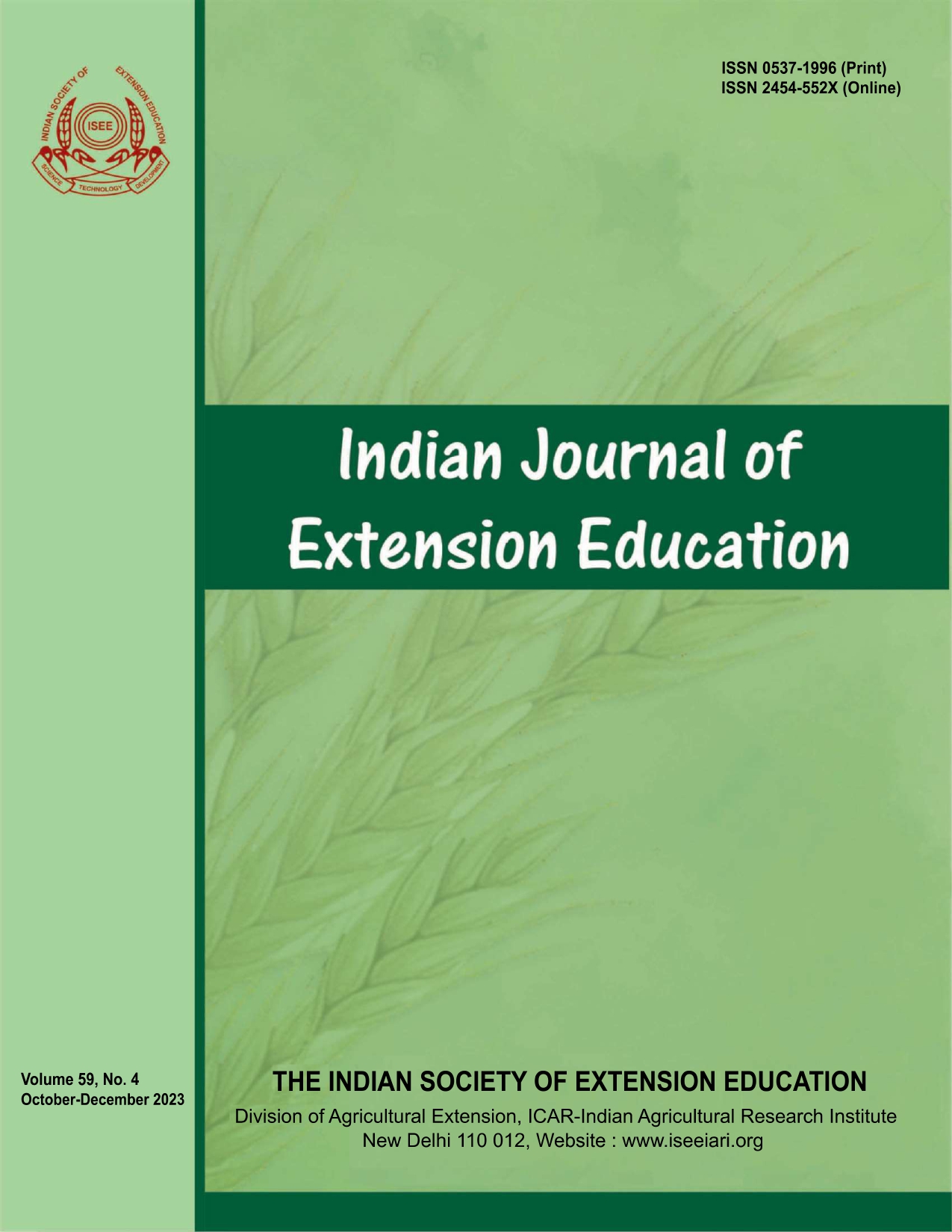Development and Standardization of Household Food and Nutritional Security Index
DOI:
https://doi.org/10.48165/IJEE.2023.59430Keywords:
Household food and nutritional security, Index development, Reliability, ValidityAbstract
An assessment of Household Food and Nutritional Security (HFNS) is important to understand the nutritional state of a household. There are various techniques available for measuring it but they are all in scattered form, making the study tedious. Present research carried out during 2022-23 was aimed at constructing a composite HFNS index that would aid in amalgamating the different techniques to holistically study the HFNS. Initially, four dimensions and 48 indicators were identified and subjected to relevancy testing through judges’ opinions which resulted in the selection of 32 indicators. A questionnaire with finalized indicators was administered to 60 households in the non-sampling area. The test retest and split-half method was followed for testing the reliability of the tool and the reliability co-efficient was 0.84 and 0.87, respectively. Content validity and statistical validity were used to confirm the validity of the tool which was 0.96. The developed tool finally consisted of four dimensions and 32 indicators which are reliable and can produce consistent results while assessing the food and nutritional security of rural households.
Downloads
References
Adjimoti, G. O., & Kwadzo, G. T. (2018). Crop diversification and household food security status: evidence from rural Benin. Agriculture and Food security, 7(82), 1-12.
Bardhan, T., Bhardwaj, N., Kashyap, S. K., Kameswari, V. L. V., Kuswaha, G. S., & Dey, A. (2023). Development of multi dimensional scale to measure attitude of farmers towards conservation agricultural practices. Indian Journal of Extension Education, 59(1), 127–130.
Chand, P. (2019). Construction of a composite index. In: Nikam, V., Jhajhira, A., & Pal, S. (eds.), Quantitative methods in social sciences (pp. 351-360). National Institute of Agricultural Economics and Policy Research, New Delhi.
Chandhana, B., Kumar, G. D. S., & Sengar, R. S. (2022). Development of scale to measure sunflower farmers’ perception on public and private extension systems. Indian Journal of Extension Education, 58(3), 197-200.
Chaudhari, R. R., Hirevenkanagoudar, I. V., Hanchinal, S. N., Mokashi, A. N., Katharki, P. A., & Banakar, B. (2007). A scale for
measurement of entrepreneurial behaviour of dairy farmers. Karnataka Journal of Agricultural Science, 20(4), 792-796. Food and Agriculture Organization. (1996). World Food Summit Declaration on World Food Security and World Food Summit Plan of Act. https://www.fao.org/3/w3613e/w3613e00.htm Gupta, S. K., Nain, M. S., Singh, R., & Mishra, J. R. (2022). Development of scale to measure agripreneurs attitude towards entrepreneurial climate. Indian Journal of Extension Education, 58(2), 153–157.
Jatav, S. S., Nayak, S., Singh, N. P., & Naik, K. (2022). Measuring and mapping food security status of Rajasthan, India: A district-level analysis. Frontiers in Sustainable Food System, 6(831396), 1- 17.
Kerlinger, F. N. (2007). Foundation of Behavioural Research. Rinehart and Winston. Inc. New York.
Kumar, R., Slathia, P. S., Peshin, R., Gupta, S. K., & Nain, M. S. (2016). A test to measure the knowledge of farmers about rapeseed mustard cultivation. Indian Journal of Extension Education, 52(3&4), 157-159.
Mukherjee, A., Singh, P., Satyapriya, Rakshit, S., & Burman, R. R. (2018). Development and standardization of scale to measure farmer’s attitude towards Farmers’ Producer Company. Indian Journal of Extension Education, 58(4), 84–90.
Naik, A., Shivamurthy, M., & Chandre Gowda, M. J. (2019). Instrument to assess the farmers’ participation in effective canal irrigation management. Indian Journal of Extension Education, 55(2), 13–19.
Pieters, H., Guariso, A., & Vandeplas, A. (2013). Conceptual framework for the analysis of the determinants of food and nutritional security. Centre for Institutions and Economic Performance and Department of Economics, KU Leuven, Belgium.
Sharma, P., & Singh, A. K. (2017). Association of state-wise food security index with climatic factors in India: evidence from state wise panel data. Journal of Global Agriculture and Ecology, 6(3), 196-205.
Vhurumuku, E. (2014, February 17-25). Food security indicators [Workshop]. Integrating nutrition and food security programming for emergency response Workshop, Nairobi, Kenya. https:// www.fao.org
Von Grebmer, K., Bernstein, J., Resnick, D., Wiemers, M., Reiner, L., Bachmeier, M., Hanano, A., Towey, O., Ní Chéilleachair, R., Foley, C. Gitter, S., Larocque, G., & Fritschel, H. (2022). Global Hunger Index: Food Systems Transformation and Local Governance. Welthungerhilfe, Bonn and Concern Worldwide, Dublin.https//globalhungerindex.org
Wuensch, K. L. (2012). A Brief Introduction to Reliability, Validity, and Scaling. Retrieved August 30, 2023, from https:// core.ecu.edu/wuenschk/MV/FA/Reliability-Validity-Scaling.docx
Published
Issue
Section
License

This work is licensed under a Creative Commons Attribution-NonCommercial-NoDerivatives 4.0 International License.


